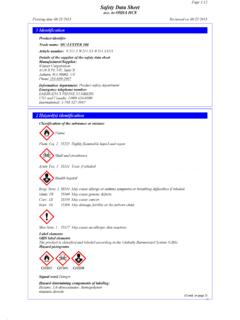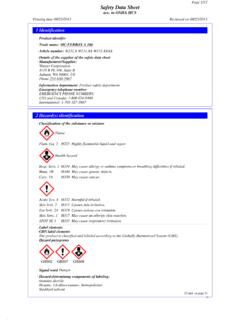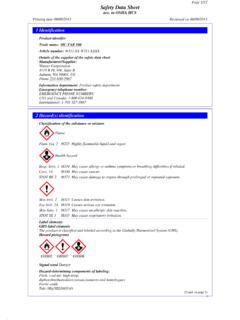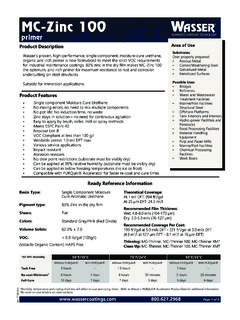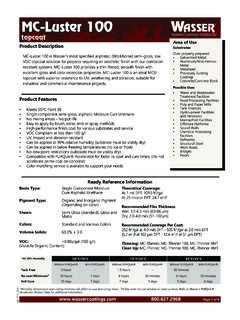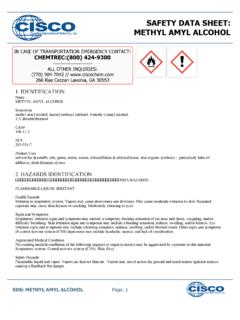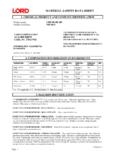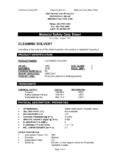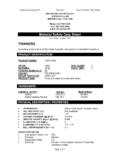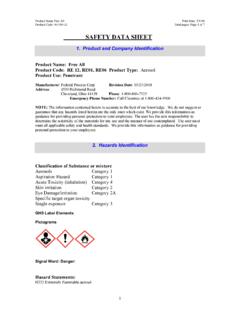Transcription of Material Safety Data Sheet - Wasser Corporation
1 Material Safety data SheetNFPAP rotective ClothingProduct NameSynonymChemical available (Paint thinner).Section 1. Chemical Product and Company IdentificationEMERGENCY PHONE NUMBERS:USA and Canada: 1-800 424-9300 International: 1-703 527-3887 ManufacturerSUPPLIER: Wasser Corporation4118 B PL NW, Suite BAuburn, WA 98001, USPhone# 253-850-2967 HCS Risk PhrasesHCS CLASS: CLASS: Irritating CLASS: Target organ CLASS: Flammable liquid having a flash point lower C (100 F).320 Page: 1 Section 2. Composition and Information on IngredientsDate Originated: 08/06/2009In case of EmergencyXylenes1330-20-760-100 TWA: 100 STEL: 150 (ppm)from OSHA (PEL)ORAL (LD50): Acute: 4300mg/kg [Rat]. DERMAL(LD50): Acute: 2000 mg/kg[Rabbit]. VAPOR (LC50):Acute: 6700 ppm 4 hour(s)[Rat]. methyl isobutyl ketone108-10-110-30 TWA: 50 STEL: 75 (ppm)from ACGIH (TLV)TWA: 50 STEL: 75 (ppm)from OSHA (PEL)ORAL (LD50): Acute: 2080mg/kg [Rat].
2 2850 mg/kg[Mouse]. VAPOR (LC50):Acute: 2000 ppm 4 hour(s)[Rat].NameCAS #TLV/PEL% byWeightLC50/LD50 Section 3. Hazards IdentificationPotential Chronic HealthEffectsPotential Acute Health EffectsRoutes of Entry:Inhalation. Skin contact (absorption). Eye contact. or spray mist may severely irritate eyes. Inflammation of the eye is characterized by redness,watering, and product may irritate skin upon contact. Harmful if absorbed through the skin. Skin inflammation ischaracterized by itching, scaling, reddening, or, occasionally, if swallowed. Irritation or chemical burns of the mouth, pharynx, esophagus and stomach candevelop following ingestion of this product. Even small amounts of liquid aspirated into the lungs duringingestion or vomiting may cause pulmonary injury and possibly if inhaled (irritant).
3 Over-exposure by inhalation of the vapors/spray mist may produce severeirritation of respiratory tract, characterized by coughing, choking, or shortness of breath. Exposure cancause nausea, headaches and vomiting. Severe overexposure can cause unconsciousness and :Skin:Ingestion:Inhalation:Repeated or prolonged contact with spray mist may produce chronic eye skin exposure can produce local skin destruction, or be fatal if or prolonged inhalation of vapors/spray mist may lead to chronic respiratory :Skin:Ingestion:Inhalation:DO NOT induce vomiting. Have conscious person drink several glasses of water or milk. Seek immediatemedical ContactSkin ContactHazardous InhalationInhalationIngestionHazardous IngestionCheck for and remove any contact lenses. IMMEDIATELY flush eyes with running water for at least 15 minutes,keeping eyelids open.
4 DO NOT use an eye ointment. Seek medical gently and thoroughly the contaminated skin with running water and non-abrasive soap. Rinse with plentyof running water (15 to 30 minutes). If irritation persists, seek medical the chemical gets onto the clothed portion of the body, remove the contaminated clothes as quickly aspossible, protecting your own hands and body. Place the person under shower. Wash gently and thoroughlythe contaminated skin with running water and non abrasive soap. Be particularly careful to clean folds, crevices,creases and groin. Rinse with plenty of running water (15 to 30 minutes). Seek medical the person to rest in a well ventilated area. If symptoms persist, seek medical advice immediately (showthe label when possible).Evacuate the person to a safe area as soon as possible.
5 Loosen tight clothing around the person's neck andwaist. If the person is not breathing, administer mouth-to-mouth resuscitation. Warning: It may be dangerousto the person providing aid to give mouth-to-mouth resuscitation if the inhaled Material is toxic, infectious orcorrosive. Oxygen may be administered if breathing is difficult. Seek medical NOT induce vomiting. Have conscious person drink several glasses of water or milk. Never give anunconscious person anything to ingest. Even small amounts of liquid aspirated into lungs during ingestion orfrom vomiting may cause mild to severe pulmonary injury and possibly death. If breathing is difficult, administeroxygen. If the person is not breathing, administer mouth-to-mouth resuscitation. WARNING: It may bedangerous to the person providing aid to give mouth-to-mouth resuscitation when the Material is toxic, infectiousor corrosive.
6 Avoid mouth-to-mouth contact by using mouth guards or shields. Seek immediate 4. First Aid MeasuresHazardous Skin ContactMaterial Safety data SheetProduct Name:MC-ThinnerOther chronic effects onHumansThe substance is toxic to mucous membranes, upper respiratory tract, lungs, blood, kidney, may cause asthma, dermatitis and pulmonary oedema; effects may be : 2 Flammability of the ProductAuto-Ignition TemperatureThe lowest known value is 443 C ( F) ( methyl isobutyl ketone). oxides (CO, CO2), and other unidentified, possibly toxic lowest known value is CLOSED CUP: 16 C ( F). (Tagliabue.). OPEN CUP: 26 C ( F). (Tagliabue).( methyl isobutyl ketone)The greatest known range is LOWER: UPPER: 8% ( methyl isobutyl ketone)SMALL FIRE: Use DRY chemicals, CO2, water spray or FIRE: Use water spray or fog.
7 Never direct a water jet in the container in order to prevent any splashingof the product which could cause spreading of the fire. Cool the containers with water spray or fog in order toprevent pressure build-up, autoignition or in presence of open flames and may travel considerable distance to source of ignition and flash back. When heated to decomposition itemits toxic fumes. Liquid will float and may reignite on surface of of explosion of the product in presence of mechanical impact: Not of explosion of the product in presence of static discharge: explosion may occur under fire conditions or when heated (due to pressure build-up). Vapor formsexplosive mixture with air between upper and lower flammable 5. Fire and Explosion DataHealthFlammabilityReactivitySpecial Hazard203 Section 6.
8 Accidental Release MeasuresSmall SpillLarge SpillAbsorb with an inert Material and put the spilled Material in an appropriate waste disposal. Wear suitableprotective clothing and proper flammable liquid, insoluble or very slightly soluble in water. Ventilate. Eliminate all sources of full protective equipment, including respiratory equipment during clean-up. Stop leak if without risk. DONOT touch spilled Material . Prevent entry into storm or sanitary sewers, lakes, rivers, streams or publicwaterways. Call for assistance on Safety data SheetProduct Name:MC-ThinnerFlash PointsFlammable LimitsProducts of CombustionFire Hazards in Presence ofVarious SubstancesExplosion Hazards in Presenceof Various SubstancesFire Fighting Mediaand InstructionsSpecial Remarks onFire HazardsSpecial Remarks on ExplosionHazardsPage: 3 The lowest known value is 117 C ( F)( methyl isobutyl ketone).
9 Weighted C ( F)Section 9. Physical and Chemical PropertiesVolatilityOdor ThresholdWater/Oil Dist. (in Water)Dispersion start to solidify at -85 C (-121 F)based on data for: methyl isobutyl (Water = 1)The highest known value is (Air = 1)(Xylenes). Weighted average: (Air = 1)The highest known value is 15 mm of Hg (@20 C) ( methyl isobutyl ketone). Weightedaverage: mm of Hg (@ 20 C)Not not dispersed in in highest known value is 8 ppm (Methylisobutyl ketone) Weighted average: ppmNot TemperatureConditions of InstabilityStabilityCorrosivitySpecial Remarks onReactivityThe product is considered to be corrosive for glass and metals according to our data with strong oxidizing additional 10. Stability and Reactivity DataNot additional with varioussubstancesMaterial Safety data SheetProduct Name:MC-ThinnerPhysical state andappearanceMolecular WeightpH (1% soln/water)Boiling PointMelting PointCritical TemperatureSpecific GravityVapor PressureVapor DensityColorTasteOdorPage: 4 Evaporation rateThe highest known value is ( methyl isobutylketone).
10 Weighted average: to materials should be stored in a separate Safety storage cabinet or room. Keep away from heat. Keepaway from sources of ignition. Keep container tightly closed and in a well-ventilated place. Keep away fromincompatibles. A refrigerated room would be preferable for materials with a flash point lower than C (100 F).Keep locked up and out of reach of children. Manipulate in a well ventilated area. In case of insufficient ventilation, wear suitable respiratoryequipment. Do not breathe gas/fumes/vapor/spray. Avoid contact with skin and eyes. Contact lenses should not be worn when working withchemicals because they may contribute to the severity of an eye injury. Keep away from foodstuff, drinks and tobacco. Eating, drinking andsmoking should be prohibited in area where this Material is handled, stored and processed.
